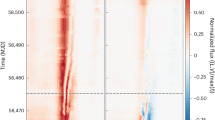Abstract
The orthogonal polarization modes (OPM) have been reported observationally and widely accepted by pulsar researchers. However, no acceptable theory can explain the origin of the OPM, which becomes a mystery in pulsar research field. Here a possible way to solve this mystery is presented. We ask a question: Does there exist any real so-called OPM in pulsar radiation? It is proposed that the ‘observed OPM’ in individual pulses could be the results of depolarization of pulsar radiation and the observational uncertainties originated from polarimeter in observation. A possible method to check this idea is suggested. If the idea is verified, the pulsar research would be influenced significantly in theory and in observation
Similar content being viewed by others
References
Stinebring, D. R., Codes, J. M., Rankin, J. M., Pulsar polarization fluctuation I: 1404 MHz statical summaries, Ad, 1984, 55(Supp.): 247.
Mckinnon, M. M., Stinebring, D. R., A statistical model for the orthogonal modes of polarization in pulsars radio emission, Ad, 1998, 502: 883.
Gangadhara, R. T., Orthogonal polarization mode phenomenon in pulsars, A&A, 1997, 327: 155.
Hankins, T. H., Microstructure: A review, in Pulsars: Problems and Rogmss (eds. Johnston, S., Walker, M. A., Bailer, M.), Vol. 105, San Francisco: ASP, 1996, 197–202.
Xu, R. X., Qiao. G. J., Two possibilities of observed position angle jumps in pulsar radio emission, inProc. of the 21st Chinese Astronomy Conf. (ed. Cheng, K. S.), Singapore: World Scientific, 1997, 197–300.
Xu, R. X., Qiao, G. J., Han, J. L., Depolarization and position angle jumps due to relative longitude shift of pulsar beams, A&A, 1997, 323: 395.
Qiao, G. J., Lin. W. P., An inverse Compton scattering (ICS) model of pulsar emission I: Core and conal emission beams, A&A, 1998, 333: 172.
Manchester, R. N., Taylor, J. H., Pulsars, New York: W. H. Freeman and Company, 1977, 202.
Backer, D. C., Rankin, J. M., Statistical summaries of polarized pulsar radiation, ApJS, 1980, 42(Supp.): 143.
Rathnsree, N., Rakin, J. M., On ‘orthogonal’ polarization modes in pulsars: A study of PSR 2120 + 27, Ash. Lett. & Commu., 1996, 35: 281.
Author information
Authors and Affiliations
Corresponding author
Rights and permissions
About this article
Cite this article
Xu, R., Qlao, G. Are there real orthogonal polarization modes in pulsar radio emission?. Sci. China Ser. A-Math. 43, 439–448 (2000). https://doi.org/10.1007/BF02897168
Received:
Issue Date:
DOI: https://doi.org/10.1007/BF02897168




